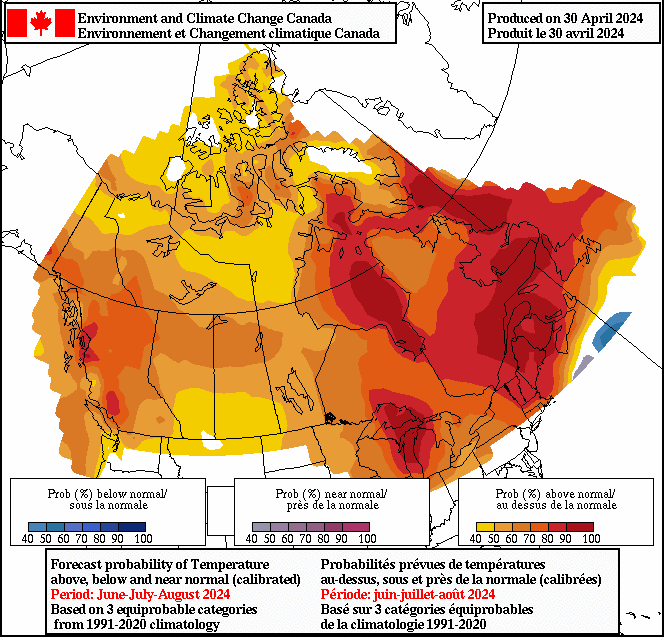2023 was an exceptional year, marking a turning point in the history of forest fires in Quebec and Canada. From coast to coast, more than 6,600 fires ravaged the country’s vast boreal forests, leaving deep scars on more than 18 million hectares of woodland. Quebec was particularly hard hit by this record-breaking season, in which 4.3 million hectares of forest were burned by 713 fires. This figure is well above the annual average of 480 fires over the last ten years.
While last year’s season proved to be unusual, projections for the 2024 fire season predict conditions favourable to wildfires, which could potentially lead to another very intense season. However, it’s important to note that it’s hard to accurately predict long-term wildfire trends at the start of the season due to the inherent uncertainty of many variables, such as precipitation and wind. It is even more difficult, if not impossible, to accurately predict fire activity. However, seasonal weather forecasts can provide useful indications of future trends, helping to identify areas at risk and anticipate potential challenges.
Forecast for the 2024 fire season
Across the country, this winter was marked by above-normal temperatures and low precipitation, making widespread drought conditions more likely and aggravating the already favourable conditions for wildfires. In early April, Natural Resources Canada (2024) published the results of its latest seasonal weather forecasts, which indicate that this spring and summer could see temperatures well above seasonal normals, like the winter did. These weather conditions, exacerbated by the El Niño phenomenon, could set the stage for another active and intense forest fire season starting in the spring. According to these forecasts, the regions most likely to experience these events are western Canada, eastern Ontario and southern Quebec, in particular due to the early melting of snow.
This summer, persistent widespread drought conditions combined with temperatures well above seasonal normals could increase the risk of forest fires, particularly in northwestern Quebec, the Prairie provinces and western and northern Canada. Some specialists are also concerned about the possible resurgence of certain forest fires, particularly in the Northwest Territories, where blazes dating back to last year have never been completely extinguished, despite the winter.

Figure 1: Probabilistic temperature forecasts for Canada for the months of June-July-August 2024. (From: Natural Resources Canada, 2024.)
An early start to the season
The forest fire season started very early this year. By March and April, the Société de protection des forêts contre le feu (SOPFEU) had recorded over 60 fires in Quebec, more than during the same period last year.
It should be noted that at this time of year, the majority of forest fires are of human origin, often occurring close to inhabited areas and generally covering smaller areas. According to Yan Boulanger, a researcher with the Canadian Forest Service, it’s important to actively monitor weather conditions over the coming weeks, especially the onset of thunderstorm and lightning activity, as well as drought conditions. Drought can encourage the emergence of naturally-occurring fires, which tend to cover larger areas and occur in more remote regions, although this does not prevent them from posing a threat to essential infrastructure such as hydroelectric infrastructure. This is exactly what happened last year when high temperatures, combined with very dry conditions and lightning strikes, triggered 182 fires in Quebec on a single day: June 1, 2023.
New collective awareness
In assessing the 2023 forest fire season and its implications for the future, Boulanger points out that there is a new level of awareness in society, particularly in Quebec. While Canada’s western provinces are more familiar with forest fires, Quebec has experienced relatively calm wildfire seasons over the past ten years. This perception was challenged by the exceptional forest fire season of 2023, boosting local understanding of this danger.
Communities and infrastructure at risk
It’s important to bear in mind that although forest fires are less frequent in Quebec than in other Canadian provinces, their spread is often more ferocious, endangering more buildings and inhabited areas. The findings of a recent study published in February in the International Journal of Disaster Risk Reduction point to Quebec as the Canadian province where infrastructure is the most exposed to forest fires, directly or indirectly. More than a million buildings are at risk from fire, 15,000 of which are considered high-risk, particularly in the central and northeastern parts of the province.
Furthermore, according to the same study, between 2011 and 2016, populations grew in Quebec and Ontario in areas considered to be at high risk of forest fires, in contrast to other provinces like British Columbia, Saskatchewan and Manitoba, where numbers declined.
Increased prevention
Given these facts and the expected increase in the duration, frequency and intensity of forest fires due to climate change, adaptation measures are essential, focusing in particular on forest land management and risk mitigation for communities and infrastructure. Enhanced prevention is therefore a key strategy in a world where fires are more and more of a problem.
While the outcome of the 2024 fire season remains uncertain, current forecasts indicate that this will be another challenging year for our communities and infrastructure. Preparedness and adaptation are our best tools for dealing with this threat. These require collective and individual collaboration involving different parties. By pooling our efforts, we can face this new reality and work toward containing these fires more effectively and limiting the damage in order to build a more resilient future.